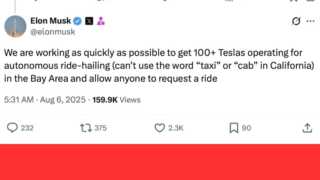In a bold move that could redefine urban mobility, Elon Musk has announced that Tesla is racing to deploy over 100 autonomous Model Y vehicles for a groundbreaking ride-hailing service in the Bay Area. Posted on X at the crack of dawn – 5:31 AM today – the Tesla CEO teased the ambitious plan, signaling a potential game-changer for the electric vehicle giant. But as with any Musk venture, the road ahead is paved with both innovation and regulatory hurdles. Let’s dive into the electrifying details!
Musk’s Vision For The Model Y Takes Shape
Elon Musk’s latest tweet has the automotive world buzzing: Tesla is working “as quickly as possible” to get 100+ Model Ys operational for an autonomous ride-hailing network in California’s tech hub. The timing couldn’t be more strategic, with the 2026 Super Bowl slated for Levi’s Stadium in Santa Clara, just a stone’s throw from the Bay Area. Imagine fleets of sleek Model Ys whisking fans to the big game – autonomously, no less! This could be Musk’s ultimate stage to showcase Tesla’s Full Self-Driving (FSD) technology to a global audience.
However, there’s a quirky twist: California regulations prohibit Tesla from labeling this service a “taxi” or “cab” due to the stranglehold of traditional taxi industry frameworks. X user @veritas_solum quipped, “T.A.X.I. – Tesla Autonomous eXperience Initiative,” a creative workaround that’s already gaining traction online. Whether it’s called that or something else, the vision is clear: a future where Tesla’s electric SUVs dominate ride-hailing without a human driver in sight.
Regulatory Roadblocks Ahead
While the idea is thrilling, the reality is more complex. Tesla’s plan hinges on navigating California’s stringent autonomous vehicle regulations, managed by the California Public Utilities Commission (CPUC) and the Department of Motor Vehicles (DMV). Unlike Waymo, which currently operates 300-400 driverless vehicles under approved permits, Tesla lacks the green light for unsupervised autonomy. According to the latest 2025 data from the DMV’s Autonomous Vehicles branch, Tesla’s FSD system remains at Level 2—meaning human supervision is still required—far from the Level 4 autonomy Musk has long promised.
X commentator @SawyerMerritt, who broke the news from Elon Musk’s tweet reply, clarified, “I don’t think it’s a production issue, but a regulatory one,” echoing concerns from @GrindeOptions: “Regs are holding them back and can indefinitely if bureaucrats want to.” This regulatory lag contrasts sharply with Tesla’s trial robotaxi service in Austin, Texas, where looser rules allowed a limited launch last month. The Bay Area rollout, for now, will rely on supervised FSD, with human safety drivers keeping a watchful eye.
Watch my opinions on Elon’s new revolution of the Model Ys in the SF Bay area on the Torque News YouTube channel below in this video.
Advertising
Super Bowl Spotlight or Stalled Dream Tesla FSD?
The Super Bowl 2026 tie-in adds a layer of intrigue. X user @KeethBrown noted, “Smart! 2026 Super Bowl in this very location,” suggesting Tesla could use the event to steal the spotlight. Images shared by @doge_eth_gov of a Model Y parked near Levi’s Stadium hint at early testing, fueling speculation of a high-profile debut. Yet, with regulatory approvals pending, this could be more of a staged demo than a full-scale launch.
Tesla’s Fremont factory, just miles from the Bay Area, ensures production isn’t the bottleneck – Model Ys are rolling off the line at a blistering pace. The challenge in EV regulatory issues lies in convincing regulators that FSD is ready for prime time. Recent shareholder lawsuits, reported by Reuters on August 5, accuse Musk and Tesla of overstating autonomous tech capabilities, adding pressure to deliver tangible results.
What’s Next for Tesla and the Model Y?
For Tesla enthusiasts, this is a tantalizing glimpse of Musk’s robotaxi future, a cornerstone of his plan to pivot from traditional car sales to a mobility service model. The Model Y, already a sales juggernaut, could become the backbone of this network, blending performance with cutting-edge autonomy. But as @TailosiveEV pointed out, “It’s just FSD supervised lol. The only thing they need is drivers,” a reminder that the tech isn’t fully there yet.
Torque News predicts that Tesla will push hard to secure permits by late 2025, potentially scaling the Bay Area fleet to 500 vehicles by mid-2026 if approvals come through. Meanwhile, X user @NearMeMike asked, “When Austin robotaxi fleet will be available for the general public?” – a sign that Tesla’s multi-city strategy is gaining momentum, with Texas as a testing ground.
Elon Musk’s Tesla Model Y rollout is a bold step toward autonomous ride-hailing, but it’s a race against time and red tape. Will the Bay Area become a proving ground for Tesla’s future, or will regulatory roadblocks stall the revolution? One thing’s for sure: with Musk at the helm, expect the unexpected. Stay tuned to Torque News for the latest updates as this story unfolds!
Have an opinion? Drop your thoughts in the comments below, and let us know if you’d ride in a Model Y robotaxi! Follow us for more Tesla breaking news and subscribe to our newsletter for exclusive insights. Drive on!
Armen Hareyan is the founder and Editor-in-Chief of Torque News. He founded TorqueNews.com in 2010, which since then has been publishing expert news and analysis about the automotive industry. He can be reached at Torque News Twitter, Facebook, Linkedin, and Youtube. He has more than a decade of expertise in the automotive industry with a special interest in Tesla and electric vehicles.
Source: torquenews.com






